Year-in-Review: 2019 Magazine Summary
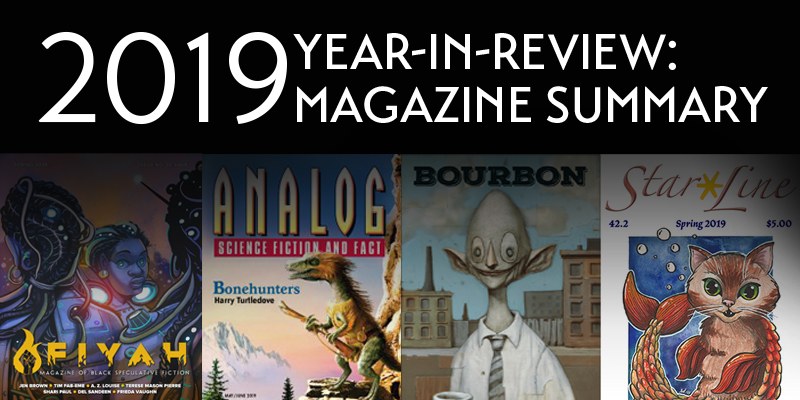
The following sections are primarily sorted by Hugo Eligibility: Professional, Semiprozine, etc., and then loosely by pay rate, SFWA qualifying market, and the amount of fiction published. We covered 82 magazines, 17 audio sites, and eight critical magazines.
We continue to see new venues launching under the crowdfunding format, older venues trying out print or subscription models, and of course funding by grants in non-US venues. A few magazines shut down this year, one came out of hiatus, and we added a number of markets to our summary. We asked publishers which Hugo Award category they qualify for, and have included the information provided this year (or last year) in brackets at the end of each write up; we also used the data from <semiprozine.org> or our best determination. Any of the editors or publishers named would generally be eligible for Best Editor, Short Form, and the non-fiction magazines would generally be eligible for Related Work.
We use the Statement of Ownership, required for use of a periodical permit, plus numbers as provided, to get subscriber and newsstand sales for those who generate one, though this becomes less meaningful with digital numbers on the rise. We have included print-plus-digital circulation figures for Analog, Asimov’s, and Locus wrapped into subscription numbers, keeping sell-through number just for print (since there are no digital returns). There is no digital circulation information from F&SF.
PROFESSIONAL MAGAZINES
 Analog, <www.analogsf.com>, had 10,372 print subscriptions and 8,914 digital, for a total of 19,286, down from last year’s 20,189. Newsstand sales were 3,176, up from 2,880. Paid circulation went down 2.6%; sell-through was 42.9%, up from last year’s 39%.
Analog, <www.analogsf.com>, had 10,372 print subscriptions and 8,914 digital, for a total of 19,286, down from last year’s 20,189. Newsstand sales were 3,176, up from 2,880. Paid circulation went down 2.6%; sell-through was 42.9%, up from last year’s 39%.
Analog produced six tall, digest-size double issues with 208 pages each. Cover price was $7.99. There were three novellas, 26 novelettes, 91 short stories, six “Science Fact” pieces, and two “Probability Zero” pieces, for a total of 120 pieces of fiction (way up from last year’s 88), plus 11 poems. Covers included a baroquely ornamented space station, an astronaut tethered to a space pod, and a humorous depiction of a fuzzy reptilian alien. Editor Trevor Quachri said, “Emily Hockaday was promoted to Managing Editor (for both Analog and Asimov’s) and we hired a new editorial admin assistant, Rae Purdom. We also coordinated with Professor Jason Ellis to put on a symposium at City Tech College in Brooklyn, on December 12, to kick off our 90th anniversary year…. In 2020, each issue features a retro logo (but new art), as well as a retrospective on an important story from Analog/Astounding’s history, and of course we have tons of great fiction, including a serial and stories from Harry Turtledove, Neal Asher, Tom Jolly, Maggie Clark, Marie Vibbert, Adam-Troy Castro, Ramona Louise Wheeler, and more!” Analog paid 8-10 cents per word for short fiction, and 6 cents per word for serials. [Professional]
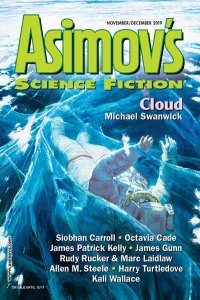 Asimov’s, <www.asimovs.com>, had 6,689 print subscriptions and 10,584 digital subscriptions for a total of 17,273, down a little from 17,687 last year. Newsstand sales were 2,415, up from 2,265, at 36% sell-through, up from last year’s 35%. Total paid circulation went down 1.3%.
Asimov’s, <www.asimovs.com>, had 6,689 print subscriptions and 10,584 digital subscriptions for a total of 17,273, down a little from 17,687 last year. Newsstand sales were 2,415, up from 2,265, at 36% sell-through, up from last year’s 35%. Total paid circulation went down 1.3%.
Asimov’s produced six tall, digest-size double issues with 208 pages each. There were 10 novellas, 23 novelettes, and 34 short stories (one a reprint), for 67 pieces of fiction, up from 66 last year, plus 32 poems. Cover price was $7.99. Covers featured a giant robot emerging from an icy lake, an astronaut trapped within an ice floe, and a set of pulp-style glowing life pods attended by a shadowy beaked figure and a man. Editor Sheila Williams said, “We published some terrific stories in 2019…. by Megan Arkenberg, Siobhan Carroll, Andy Duncan, Eileen Gunn, Zhao Haihong, Alexander Jablokov, James Patrick Kelly, Ted Kosmatka, Michael Libling, Sandra McDonald, Ian McHugh, Tegan Moore, Kofi Nyameye, Suzanne Palmer, Ray Nayler, Mercurio D. Rivera, Gord Sellar, Harry Turtledove, Carrie Vaughn, Kali Wallace, E. Lily Yu, and many others…. Our website continues to be a lively place to visit for podcasts, interviews, and blog posts.” Asimov’s paid 8-10 cents per word. [Professional]
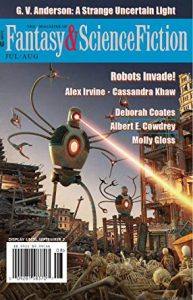 F&SF, <www.sfsite.com/fsf>, showed subscription numbers of 5,363 in its Statement of Ownership, down from 6,688 the prior year, with 1,980 copies sold on newsstands and sell-through of 33%. Paid circulation was down an alarming 21%, but according to publisher Gordon Van Gelder, this was due to an error detected in the math from prior years and is a clerical concern rather than a cause for alarm about the future of the magazine. As always, without digital figures available it’s difficult to say how well the magazine did overall.
F&SF, <www.sfsite.com/fsf>, showed subscription numbers of 5,363 in its Statement of Ownership, down from 6,688 the prior year, with 1,980 copies sold on newsstands and sell-through of 33%. Paid circulation was down an alarming 21%, but according to publisher Gordon Van Gelder, this was due to an error detected in the math from prior years and is a clerical concern rather than a cause for alarm about the future of the magazine. As always, without digital figures available it’s difficult to say how well the magazine did overall.
F&SF produced six digest-size double issues, each 258 pages: three novellas, 21 novelettes, and 42 short stories for 66 pieces of fiction, up from 63 last year, plus nine poems and some non-fiction. Cover price was $8.99. Cover art was good quality, with a cigar-smoking cyborg in an Eiffel tower scene reverted to primordial forest, cyclopean robots beaming down death rays on an urban ruin, and a colorful scene of a bipedal alien clutching a gunshot wound.
Several stories were finalists for awards, and “Down Where Sound Comes Blunt” by G.V. Anderson won the British Fantasy Award for Short Fiction, F&SF and editor C.C. Finlay were finalists for the Locus Award (Best Magazine and Best Editor respectively), and Finlay was also a finalist for the World Fantasy Award for Special Award, Professional. Nine stories from F&SF were reprinted 10 times in eight different Year’s Bests.
Finlay said, “The highlight of the year was the 70th Anniversary issue we released in Sept/Oct, with an essay from Robert Silverberg on his history with the magazine, going back to the first issue, and stories by Michael Moorcock (his first in F&SF), Kelly Link, Paolo Bacigalupi, Elizabeth Bear, Ken Liu, and others, including ‘Homecoming,’ the last story finished by Gardner Dozois before he passed away.… I thought it was the best year for stories by far since I’ve started editing.” Pay rate increased to 8-12 cents a word. [Professional]
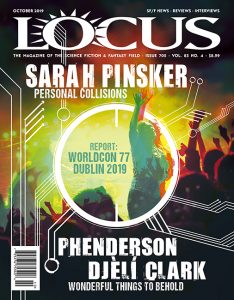 Locus, <locusmag.com>, we list here since we are professional and have Statement of Ownership numbers in the charts, although we also qualify as Related Work.
Locus, <locusmag.com>, we list here since we are professional and have Statement of Ownership numbers in the charts, although we also qualify as Related Work.
Paid circulation was up 4.0% in 2019. Sell-through was 47%, up from 42% last year. Subscription numbers held at 2,977, mostly flat compared to 2,992 last year.
The print cover price increased from $7.50 to $8.99 with the May 2019 issue and digital increased from $5.50 to $5.99 in June. Twelve monthly issues – print, online, and electronic – included reviews, news, convention coverage, book listings, international reports, special features, interviews with new and established authors, and regular commentary from Cory Doctorow and Kameron Hurley on alternating months.
We ran 571 reviews of SF, fantasy, horror, and YA fiction, up from 541 last year, including 239 reviews from short-fiction venues. There were 35 reviews of notable audiobooks. There was one print Spotlight feature on David Baldacci. The January issue featured SF/F artists, including interviews with Charles Vess and Kathleen Jennings and four additional artist spotlights.
Convention coverage included Worldcon, World Fantasy, Readercon, StokerCon, the Nebula Conference, WisCon, Norwescon, the Locus Awards, ICFA, the Writers and Illustrators of the Future Awards, the Williamson Lectureship, etc., plus international cons HalCon in Kawasaki, Another Planet Science Fiction Convention in Beijing, ICon in Tel Aviv, Can*Con in Ottawa, and international reports on India and Israel. Divers Hands added new reviewers Alvaro Zinos-Amaro and Alec Nevala-Lee.
Liza Groen Trombi was editor-in-chief; Kirsten Gong-Wong was managing editor. After a number of increasingly exciting hack attempts on our site that slowed it to a crawl (and at one point diverted all traffic to a porn site!), we put a firewall service in place that diverts our traffic via their own IP. It doesn’t track our unique visitors, but “visitors,” which is a session by a unique IP at our site. We had an average of 1.27 million non-bot sessions per month in 2019, with 2.2 million in December. [Professional/Related Work]
Tor.com, under the Macmillan umbrella, published 22 short stories and 14 novelettes, online only, as well as artwork, commentary, and more. Associate publisher was Irene Gallo. The site won the Locus Award for Best Magazine in 2019. They “are especially proud of ‘Blood Is Another Word for Hunger’ by Rivers Solomon and ‘For He Can Creep’ by Siobhan Carroll, in which cats and demons captured the hearts of many.” Plans for 2020 include publishing original stories by Charlie Jane Anders, Sarah Pinsker, Carolyn Ives Gilman, and many others. One of the most highly regarded and highest paying markets at $.25 a word,with three to four million page views a month, they stopped accepting unsolicited short fiction submissions in January 2016. [Professional]
Terraform, <motherboard.vice.com/terraform>, published one piece of fiction weekly online, plus excerpts, articles, and more. Editor Brian Merchant said, “Near-future themes continue to resonate the most, and ones that hit hardest on current events and our social and cultural trajectories. Deepfakes, gun violence, surveillance states, climate disasters, border separation, and economic precarity….” Pay rate was $.20/word. [Professional]
 Lightspeed, <www.lightspeedmagazine.com>, edited and published by John Joseph Adams, produced 12 issues, online and electronic, with 96 short stories/novelettes (48 originals, 48 reprints), half science fiction and half fantasy, interviews, podcasts, and more. Ebook editions also included six novella reprints. Most popular titles were “A Bird, a Song, a Revolution” by Brooke Bolander, “Life Sentence” by Matthew Baker, “No Matter” by Kendra Fortmeyer, “A Leash of Foxes, Their Stories Like Barter” by Cassandra Khaw, and “The Archronology of Love” by Caroline M. Yoachim. Issues were free online, $3.99 for electronic, and $2.99 for subscribers. Average monthly unique visitors was 28,500, with 2,150 subscribers. Pay was $.08/word. [Professional]
Lightspeed, <www.lightspeedmagazine.com>, edited and published by John Joseph Adams, produced 12 issues, online and electronic, with 96 short stories/novelettes (48 originals, 48 reprints), half science fiction and half fantasy, interviews, podcasts, and more. Ebook editions also included six novella reprints. Most popular titles were “A Bird, a Song, a Revolution” by Brooke Bolander, “Life Sentence” by Matthew Baker, “No Matter” by Kendra Fortmeyer, “A Leash of Foxes, Their Stories Like Barter” by Cassandra Khaw, and “The Archronology of Love” by Caroline M. Yoachim. Issues were free online, $3.99 for electronic, and $2.99 for subscribers. Average monthly unique visitors was 28,500, with 2,150 subscribers. Pay was $.08/word. [Professional]
Nightmare, <www.nightmare-magazine.com>, also helmed by Adams, published 12 monthly issues, online and electronic, with 48 horror and dark fantasy stories (24 originals and 24 reprints). Issues were free online, $3.99 for electronic, and $2.99 for subscribers. Pay was $.06/word. Average monthly uniques was 9,900, and about 1,400 ebook subscribers. [Professional]
 Clarkesworld, <clarkesworldmagazine.com>, published 12 online, electronic, and print issues, with 70 original stories, 10 reprints, podcasts for each story, and non-fiction. Eighteen of the original stories were in translation, eight funded by a grant from LTI Korea. Covers were high quality, original art. Publisher was Neil Clarke. The website had 43,000 unique visitors per month, up from 42,000; podcast listeners increased by 1,000 to 15,000. “We had a story win the World Fantasy Award, and Neil received both a Chesley Award for Best Art Director and the Kate Wilhelm Solstice Award. We’d like to see some more positive or upbeat science fiction.” There were 3,850 digital subscribers, and 200-250 digital single-issue sales monthly. Print cover price was $7.99; electronic issues were $3.99 or $2.99 with subscription. Clarkesworld pays $.10/word. [Professional]
Clarkesworld, <clarkesworldmagazine.com>, published 12 online, electronic, and print issues, with 70 original stories, 10 reprints, podcasts for each story, and non-fiction. Eighteen of the original stories were in translation, eight funded by a grant from LTI Korea. Covers were high quality, original art. Publisher was Neil Clarke. The website had 43,000 unique visitors per month, up from 42,000; podcast listeners increased by 1,000 to 15,000. “We had a story win the World Fantasy Award, and Neil received both a Chesley Award for Best Art Director and the Kate Wilhelm Solstice Award. We’d like to see some more positive or upbeat science fiction.” There were 3,850 digital subscribers, and 200-250 digital single-issue sales monthly. Print cover price was $7.99; electronic issues were $3.99 or $2.99 with subscription. Clarkesworld pays $.10/word. [Professional]
There were 12 issues of Forever, <forever-magazine.com>, Clarke’s “reprint only” project, each featuring a novella and two short stories. The magazine was available in digital formats for $2.99 per issue or by subscription. [Professional]
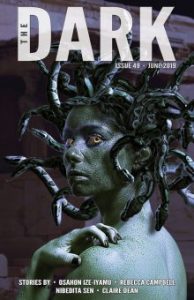 The Dark Magazine, <www.thedarkmagazine.com>, published 26 “dark and strange” stories and 12 podcast adaptations in 12 issues, online and electronic, co-edited by Sean Wallace & Silvia Moreno-Garcia. Wallace said, “Three stories that most represented the magazine included ‘After Life’ by Shari Paul; ‘The House Wins in the End’ by L Chan; and ‘Thin Places’ by Kay Chronister”. Michael Kelly joined as reprint editor. Issues were free online, $2.99 for ebook, $1.99 for subscribers. There were about 14,000 uniques monthly, up from 9,400, with about 763 paid subscribers (up from 431). Pay was $.06/word. [Professional]
The Dark Magazine, <www.thedarkmagazine.com>, published 26 “dark and strange” stories and 12 podcast adaptations in 12 issues, online and electronic, co-edited by Sean Wallace & Silvia Moreno-Garcia. Wallace said, “Three stories that most represented the magazine included ‘After Life’ by Shari Paul; ‘The House Wins in the End’ by L Chan; and ‘Thin Places’ by Kay Chronister”. Michael Kelly joined as reprint editor. Issues were free online, $2.99 for ebook, $1.99 for subscribers. There were about 14,000 uniques monthly, up from 9,400, with about 763 paid subscribers (up from 431). Pay was $.06/word. [Professional]
Galaxy’s Edge, <www.galaxysedge.com>, edited by (the now-deceased) Mike Resnick and published by Shahid Mahmud, produced six print issues between 104-116 pages, 19 x 24.5 cm, perfect bound, with b&w interiors on book print and color matte covers including an ancient pyramid taking off like a spacecraft and a scene of aliens huddled on a red-lit beach, with 76 works of short fiction, two serial installments, and 12 pieces of non-fiction. There were 8,000 average unique monthly website visitors, up from 7,000, and 1,000 subscriptions (digital and paper, including trial subs), up from 450. Fiction was free online, print cover price was $6.99 (going to $7.99 in 2020), ebook $4.99. Pay rate was $.07/word for new fiction. [Professional]
There were three issues of Amazing Stories, <amazingstoriesmag.com>, with 46 stories, two full-size regular issues with glossy color cover and b&w interior and one double-length fiction-only issue in full color. Steve Davidson was publisher and Ira Nayman was editor-in-chief. They launched the Amazing Selects stand-alone novella imprint with Allen Steele’s Captain Future in Love. Pay was $.06/word. Electronic issues were $2.99, print was $19.95. [Professional]
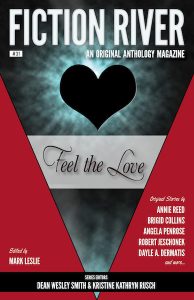 Fiction River, <www.fictionriver.com>, an “original anthology magazine,” produced three tall, digest-size regular print issues from 304-314 pages, perfect bound with glossy color covers and b&w interiors, with 56 pieces of fiction. Themes were “Feel the Love”, “Hard Choices”, and “Superstitious”; series editors were Kristine Kathryn Rusch & Dean Wesley Smith, with publisher Allyson Longueira. Cover price was $15.99, $6.99 for ebook, less for subscribers. Pay rate was $.06-$.10/word. [Professional]
Fiction River, <www.fictionriver.com>, an “original anthology magazine,” produced three tall, digest-size regular print issues from 304-314 pages, perfect bound with glossy color covers and b&w interiors, with 56 pieces of fiction. Themes were “Feel the Love”, “Hard Choices”, and “Superstitious”; series editors were Kristine Kathryn Rusch & Dean Wesley Smith, with publisher Allyson Longueira. Cover price was $15.99, $6.99 for ebook, less for subscribers. Pay rate was $.06-$.10/word. [Professional]
We saw four perfect-bound, 17.5 x 25.5 cm issues of Pulphouse, <pulphousemagazine.com>, from 144-188 pages, glossy color covers and b&w interiors, with 70 short stories, about two-thirds original. Editor was Dean Wesley Smith, with executive editor Kristine Kathryn Rusch. Publisher Allyson Longueira said, “Kent Patterson and O’Neil De Noux are frequent contributors, along with Steve Perry, Kevin J. Anderson, Kristine Kathryn Rusch, M.L. Buchman” Cover price was $7.99, $4.99 for ebook. Pay rate was $.06-$.10/word. [Professional]
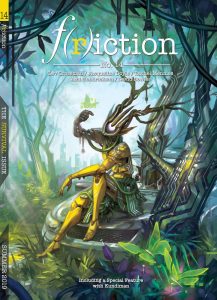 There were two issues of F(r)iction, <frictionlit.org>, published by Brink Literacy Project in print and electronically. Print was 17.5 x 25.5 cm, 116-124 pages, beautifully produced with SFnal, color glossy covers enhanced by holographic overlays and color interiors with plentiful illustrations on smooth book print, featuring 35 pieces of fiction (three reprints), and more. The magazine combined SF/F/H genre work with creative non-fiction and other literary and “weird” forms. Editor-in-chief was Brink Literacy Project CEO Dani Hedlund. They had bookstore sales of 400-500 issues and sell-through at 23-26%. Subscriptions were 370, supplemented by single-issue sales online. Pay rate was $10/”final printed page.” [ETA: F(r)iction charges a reading fee for submissions, currently $2.50 per short story. We did not have this information when we listed them in the summary.] [Professional]
There were two issues of F(r)iction, <frictionlit.org>, published by Brink Literacy Project in print and electronically. Print was 17.5 x 25.5 cm, 116-124 pages, beautifully produced with SFnal, color glossy covers enhanced by holographic overlays and color interiors with plentiful illustrations on smooth book print, featuring 35 pieces of fiction (three reprints), and more. The magazine combined SF/F/H genre work with creative non-fiction and other literary and “weird” forms. Editor-in-chief was Brink Literacy Project CEO Dani Hedlund. They had bookstore sales of 400-500 issues and sell-through at 23-26%. Subscriptions were 370, supplemented by single-issue sales online. Pay rate was $10/”final printed page.” [ETA: F(r)iction charges a reading fee for submissions, currently $2.50 per short story. We did not have this information when we listed them in the summary.] [Professional]
We saw one issue of Cemetery Dance, <www.cemeterydance.com>, saddle-stitched, 98 pages with a cover price of $9.99 and a glossy color cover, b&w interior with art, nine short stories, and extensive non-fiction. Publisher was Richard Chizmar; general manager was Brian James Freeman. The print run was 10,000 copies, with 60% going to subscribers. Pay rate was $.05/word. [Professional]
SEMIPROZINE
These are our semiprozine fiction venues. There are a ton, loosely organized by pay rate and quantity of stories printed. SFWA qualifying status is now $.08/word, so about the first half of the semiprozines qualify.
Fireside was available in print and electronically. In print as Fireside Quarterly: four exceptionally well-designed tall, digest-size issues with matte spot color illustrations and full-color glossy art on triple gatefold inserts, 120-148 pages with 57 short stories (six in translation from Spanish), 12 poems, and 12 non-fiction essays, followed by monthly ebook Fireside Magazine, after which each story was posted online, one per week, at <firesidefiction.com>. Pablo Defendini was publisher and art director; Julia Rios was fiction editor. Defendini said, “2019 was Julia Rios’ final year as our fiction editor. In 2020 we’re bringing in four guest editors [quarterly]: Dominik Parisien, LeKesha Lewis, Kate Dollarhyde, and Maurice Broaddus.” Rios commented, “It was also thrilling to see awards nominations for some of the works I edited in 2018, and I was delighted that Phenderson Djèlí Clark won multiple awards. His work is beautiful and important, and I am so glad the SFF community recognizes that.” Unique visitors averaged around 14,000 per month, up from 10,000, with 700 ebook subscribers, up from 600, and a circulation of 1,000 for Fireside Quarterly, available by subscription for $120 per year. Pay rate was 12.5 cents per word. [Semiprozine]
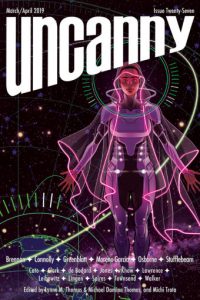 Uncanny, <uncannymagazine.com>, published six issues, online and electronic, with 35 original stories and four reprints, as well as essays, poems, interviews, and podcasts. Lynne M. Thomas & Michael Damian Thomas were co-editors-in-chief. The mag won its fourth Semiprozine Hugo Award and the 2019 British Fantasy Award for Best Magazine/Periodical. Special issue Disabled People Destroy Science Fiction (edited by Dominik Parisien & Elsa Sjunneson-Henry) won the Aurora Award for Best Related Work. “Like a River Loves the Sky” by Emma Törzs won the 2019 World Fantasy Award for Best Short Fiction; and the Thomases were finalists for Hugo and Locus Awards. Managing editor and non-fiction editor Michi Trota stepped down, assistant editor Chimedum Ohaegbu was promoted to managing editor, Elsa Sjunneson-Henry is taking over as non-fiction editor, and Angel Cruz is the new assistant editor. Issues were free online, $3.99 for electronic, and $1.99 for subscribers. Uncanny had 2,000 subscribers and averaged 30,600 uniques. Pay was $.10/word for fiction. [Semiprozine]
Uncanny, <uncannymagazine.com>, published six issues, online and electronic, with 35 original stories and four reprints, as well as essays, poems, interviews, and podcasts. Lynne M. Thomas & Michael Damian Thomas were co-editors-in-chief. The mag won its fourth Semiprozine Hugo Award and the 2019 British Fantasy Award for Best Magazine/Periodical. Special issue Disabled People Destroy Science Fiction (edited by Dominik Parisien & Elsa Sjunneson-Henry) won the Aurora Award for Best Related Work. “Like a River Loves the Sky” by Emma Törzs won the 2019 World Fantasy Award for Best Short Fiction; and the Thomases were finalists for Hugo and Locus Awards. Managing editor and non-fiction editor Michi Trota stepped down, assistant editor Chimedum Ohaegbu was promoted to managing editor, Elsa Sjunneson-Henry is taking over as non-fiction editor, and Angel Cruz is the new assistant editor. Issues were free online, $3.99 for electronic, and $1.99 for subscribers. Uncanny had 2,000 subscribers and averaged 30,600 uniques. Pay was $.10/word for fiction. [Semiprozine]
Strange Horizons, <www.strangehorizons.com>, published 48 weekly online issues with 43 stories, plus poetry, reviews, and articles. Vanessa Rose Phin became editor-in-chief in March 2019, succeeding Jane Crowley & Kate Dollarhyde. “We ran a Nigerian special issue in April, our first webcomic poems in July, and the Brazilian special issue in September…. We plan to bring on a new Fiction editor and new Poetry editor in 2020, and two themes we’re planning to visit are climate change and Mexican SFF…. We’d always like to see more stories that cross genres, queer narratives, put colonialism in a tailspin, or speak true to lived experiences.” Strange Horizons was nominated for its seventh Semiprozine Hugo in 2019, had about 77,000 hits/month (not unique visitors), and over 1,000 downloads per week from the podcast, with 325 Patreon followers. Supported by fundraising, their payrate was $.08/word, with a planned increase to $.10/word in 2020. [Semiprozine]
SH’s sister magazine Samovar, “a quarterly magazine of and about translated speculative fiction,” edited by Sarah Dodd, Laura Friis & Greg West, produced three online issues with six stories and their accompanying translations.
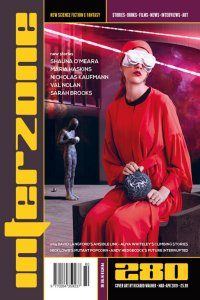 Interzone and Black Static, <www.ttapress.com>, from TTA Press are two respected genre UK print and electronic publications edited by Andy Cox. Interzone had six bimonthly print issues, 17 x 24 cm, perfect bound, with 96 pages and a glossy color cover; interiors were color on uncoated stock. There were 27 short stories and eight novelettes for 35 pieces of fiction, up from 31, plus book and film reviews and other non-fiction. Covers by Richard Wagner were digital art ranging from an oracular figure in a red gown and silver goggles to a man holding a futuristic camera emitting a blinding light. Cover price was £5.99/print, £4.99/ebook. [Semiprozine]
Interzone and Black Static, <www.ttapress.com>, from TTA Press are two respected genre UK print and electronic publications edited by Andy Cox. Interzone had six bimonthly print issues, 17 x 24 cm, perfect bound, with 96 pages and a glossy color cover; interiors were color on uncoated stock. There were 27 short stories and eight novelettes for 35 pieces of fiction, up from 31, plus book and film reviews and other non-fiction. Covers by Richard Wagner were digital art ranging from an oracular figure in a red gown and silver goggles to a man holding a futuristic camera emitting a blinding light. Cover price was £5.99/print, £4.99/ebook. [Semiprozine]
There were six print issues of Black Static, 17 x 24 cm, perfect bound, with 96 pages, a glossy color cover, and b&w interiors. Nine novelettes and 26 short stories added up to 35 pieces of fiction, up from 28 last year, plus reviews and other non-fiction. Covers were of good quality, from a seminude reptilian beauty to a moody zombie street scene. Cover price was £5.99/print, £4.99/ebook. TTA remains one of the few fiction markets that does not disclose pay rates. [Semiprozine]
Unfit (SF/H) and Unreal (F), <unrealmag.com>, “primarily digital with a limited print run” magazines edited by Daniel Scott White, published 30 stories: 19 originals (three non-fiction), and 11 reprints, in two issues of each (four total). Pay was $.12/word. White said, “Would love to see more humorous stories. And an award category for humour.” [ETA: They use a submission platform that is free for the first three months, and then there is a $9 per year charge. We did not have this information when we listed them in the summary.] [Unfit: Semiprozine; Unreal is too new.]
Diabolical Plots, <www.diabolicalplots.com>, edited by David Steffen, published 26 original stories in 12 monthly online issues, plus 20 reprints in The Long List Anthology Volume 5. Steffen said he “Incorporated slushreaders (first readers) much more heavily this year…. Planned changes for 2020 – considering giving some of the first readers more responsibility when they’re willing and able. What I would like to see more of: weird and unexpected and funny.” Pay was $.10/word, $.01/word for reprint fiction + royalty share for the anthology. Uniques/month averaged about 2,500, with 400 newsletter subscribers. [Semiprozine]
 Lady Churchill’s Rosebud Wristlet, <smallbeerpress.com/lcrw>, produced two saddle-stitched, oversize chapbooks, with b&w covers (one on vivid yellow-orange cardstock) and b&w interiors, each 60 pages, with 18 high-quality, original short stories and three poems. Print subscriptions increased back up to 220 from 180; ebook subscriptions rose from 70 to 80. Co-editors were Gavin J. Grant & Kelly Link. Of 2020, Grant says, “We have a special issue planned with two novellas.” Cover price was $5.00, $2.99 for ebook. Pay rate was $.03/word, $25 minimum, and $10/poem. [Semiprozine]
Lady Churchill’s Rosebud Wristlet, <smallbeerpress.com/lcrw>, produced two saddle-stitched, oversize chapbooks, with b&w covers (one on vivid yellow-orange cardstock) and b&w interiors, each 60 pages, with 18 high-quality, original short stories and three poems. Print subscriptions increased back up to 220 from 180; ebook subscriptions rose from 70 to 80. Co-editors were Gavin J. Grant & Kelly Link. Of 2020, Grant says, “We have a special issue planned with two novellas.” Cover price was $5.00, $2.99 for ebook. Pay rate was $.03/word, $25 minimum, and $10/poem. [Semiprozine]
Beneath Ceaseless Skies, <www.beneath-ceaseless-skies.com>, a biweekly “literary adventure fantasy” magazine published and edited by Scott H. Andrews, produced 26 online issues containing 54 pieces of original fiction, 21 podcast episodes, including their eleventh anniversary double-issue. Andrews said, “Accolades included a seventh Hugo finalist for Best Semiprozine, a tenth World Fantasy Award finalist, and Editor-in-Chief/Publisher Scott H. Andrews winning the World Fantasy Award Special Award – Non-Professional” The website averaged 76,000 uniques per month; podcasts had 12,000. Plans for 2020: a fifth biannual science-fantasy theme month in March, including stories by Yoon Ha Lee and Rich Larson; the 300th issue in April; and a donation drive on Patreon to fund paying the magazine’s staff. Pay rate was $.06/word through June 6, then $.07, then $.08 after August 31. [Semiprozine]
Daily Science Fiction, <dailysciencefiction.com>, co-published and co-edited by Michele-Lee Barasso & Jonathan Laden, published 261 stories, online and by email delivery. Pay was $.08/word up to 1,500 words. [Semiprozine]
Abyss & Apex Magazine, <www.abyssapexzine.com>, published 25 original stories, plus book reviews, editorials, and poems in four quarterly issues, plus a holiday story. Editor and publisher Wendy S. Delmater said, “We published our third-in-a-series Best of Abyss & Apex anthology in December…. My 2019 personal favorites, as publisher, were ‘Through the Iris’ by Tyler Wells Lynch, ‘Ars Poetica’ by David F. Shultz, ‘One Soul, Parchment Thin’ by Calder Hutchinson, and ‘Exactly What You Need’ by Brandon Crilly.” Average unique visitors per month was 12,996. Pay was $.08/word to 1,000 words, with a max of $80. [Semiprozine]
Mysterion, <www.mysteriononline.com>, edited and published by Donald S. Crankshaw & Kristin Janz, published 16 stories in blog format: three reprints and 13 originals. “We’d like to see more science fiction (most submissions are fantasy or supernatural), especially stories with Christians as protagonists rather than antagonists; and more stories by and about Christians in Latin America, Africa, and Asia.” Pay was $.08/word for originals, $.04/word for reprints, with 360 average unique visitors per month and 4000+ hits per month. [Semiprozine]
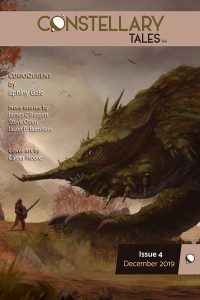 Constellary Tales, <constellary.com>, co-published and co-edited by Brian Hirt & Ken Gerber, published 13 original short stories in three online issues, plus regular podcast episodes. Hirt said, “We learned a lot as we figured out what our magazine is (and isn’t) and how it fits with our podcast. We’re looking at 2 issues per year moving forward.” Pay was $.08/word. [Semiprozine]
Constellary Tales, <constellary.com>, co-published and co-edited by Brian Hirt & Ken Gerber, published 13 original short stories in three online issues, plus regular podcast episodes. Hirt said, “We learned a lot as we figured out what our magazine is (and isn’t) and how it fits with our podcast. We’re looking at 2 issues per year moving forward.” Pay was $.08/word. [Semiprozine]
Bourbon Penn produced three perfect-bound issues, 12.75 x 20 cm, 148-167 pages, with color, glossy covers and b&w interiors, with 21 original short stories, also available in ebook and for free at <www.bourbonpenn.com>. Editor Erik Secker said, “One of our stories won an Aurealis Award, another was included in the collection which won the Shirley Jackson Award, and a third was included in a collection that was named a New York Times Notable Book of the Year: ‘The Further Shore’ by J. Ashley Smith, ‘Pearls’ by Priya Sharma, and ‘Swim Wants to Know If It’s as Bad as Swim Thinks’ by Paul Tremblay, respectively…. For 2020: we will be raising our payment rate to 2¢/word.” Print cover price went up to $12.95; ebook remained $2.99. Pay rate was $.01/word. [Semiprozine]
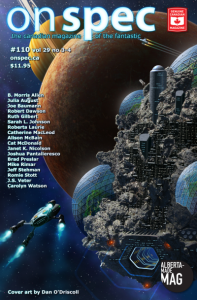 We saw two regular and one double issue of On Spec, <www.onspecmag.wordpress.com>, a Canadian print digest, 118-186 pages, perfect bound, including 32 stories (29 originals), three poems, and assorted non-fiction. Semi-gloss covers ranged from a tiny dragon drinking a dew drop to an astronaut gazing at his caveman reflection. Average print run was about 400, down from 550-600, with 97% of print sales direct to subscribers. Diane L. Walton was managing editor and The Copper Pig Writers’ Society was publisher. Walton said, “During 2019, there was a change in government at the provincial level…. While we were able to use our 2018 grant funds for production this year, we have yet to learn how much we will be granted for next year’s production…. So, along with the rest of our province’s cultural industries, we are holding our collective breaths at this time.” Regular issue price was C$6.95, double issue was C$11.95. Pay rates ran from C$.03 to C$.125/word. [Semiprozine]
We saw two regular and one double issue of On Spec, <www.onspecmag.wordpress.com>, a Canadian print digest, 118-186 pages, perfect bound, including 32 stories (29 originals), three poems, and assorted non-fiction. Semi-gloss covers ranged from a tiny dragon drinking a dew drop to an astronaut gazing at his caveman reflection. Average print run was about 400, down from 550-600, with 97% of print sales direct to subscribers. Diane L. Walton was managing editor and The Copper Pig Writers’ Society was publisher. Walton said, “During 2019, there was a change in government at the provincial level…. While we were able to use our 2018 grant funds for production this year, we have yet to learn how much we will be granted for next year’s production…. So, along with the rest of our province’s cultural industries, we are holding our collective breaths at this time.” Regular issue price was C$6.95, double issue was C$11.95. Pay rates ran from C$.03 to C$.125/word. [Semiprozine]
Future Science Fiction Digest, <future-sf.com>, launched in 2018, published four issues with 30 original stories and one reprint “with a strong focus on translation and international fiction.” Editor Alex Shvartsman said, “We’re no longer sponsored by the Future Affairs Administration, so going forward unless we can re-negotiate that sponsorship or another one, the issues are going to be a lot shorter. Approximately 10,000 words… instead of 50,000. There’s been excellent response to our translations and international fiction, especially stories from China and Russia. I also want to feature more stories out of Africa and Middle East.” Pay was $.08-.10/word. There were roughly 14,500 unique visitors in the past year. Fiction is free online, $2.99/ebook. [Semiprozine]
 We saw four issues of new magazine DreamForge, <dreamforgemagazine.com>. Print was 56-60 pages, full-size with matte color covers and color interior on smooth book print, with 47 stories, mostly original, and three poems. Publisher and editor Scot Noel is looking for “hopepunk, solarpunk, and stories with an optimistic, empathetic viewpoint.” Average print run was around 300, with 1,500 unique web visitors, and about 4,200 page views a month. Subscription only, $39.99/year for print plus digital, $19.99 for digital. Pay rate was $.06 to $.08/word. [Semiprozine]
We saw four issues of new magazine DreamForge, <dreamforgemagazine.com>. Print was 56-60 pages, full-size with matte color covers and color interior on smooth book print, with 47 stories, mostly original, and three poems. Publisher and editor Scot Noel is looking for “hopepunk, solarpunk, and stories with an optimistic, empathetic viewpoint.” Average print run was around 300, with 1,500 unique web visitors, and about 4,200 page views a month. Subscription only, $39.99/year for print plus digital, $19.99 for digital. Pay rate was $.06 to $.08/word. [Semiprozine]
Deep Magic, <deepmagic.co>, “the e-zine of clean fantasy and science fiction,” published 26 stories online, including six bonus stories from their board of directors in the Fall Issue, on a quarterly schedule. Pay rate was $.06/word up to 9,999 words and $.02/word for reprints. Managing editor Brendon Taylor said, “As our readers are generally consuming an entire story in one sitting, they are hoping for an emotional ride, or adventure – everything they would get from a novel – but packed into a short story…. Not only do the Deep Magic stories avoid any ‘messaging’, our stories often address hardship and heart break.” [Semiprozine]
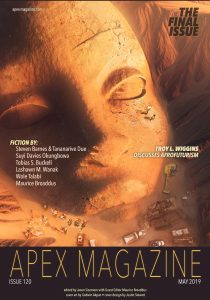 Apex, <www.apex-magazine.com>, on hiatus since the May issue for financial and health reasons, according to publisher and editor-in-chief Jason Sizemore, produced five issues with 22 stories, one novel excerpt, and assorted non-fiction including reviews and interviews. The final issue, a “special Afrofuturism issue,” was guest edited by Maurice Broaddus. The magazine was available free online, $2.99/ebook. Pay rate was $.06/word. [Professional]
Apex, <www.apex-magazine.com>, on hiatus since the May issue for financial and health reasons, according to publisher and editor-in-chief Jason Sizemore, produced five issues with 22 stories, one novel excerpt, and assorted non-fiction including reviews and interviews. The final issue, a “special Afrofuturism issue,” was guest edited by Maurice Broaddus. The magazine was available free online, $2.99/ebook. Pay rate was $.06/word. [Professional]
Orson Scott Card’s Intergalactic Medicine Show, <www.intergalacticmedicineshow.com>, published 16 original stories and three reprints in three issues, before closing with the June 2019 issue. Editor-in-chief Scott Roberts said, “We are proud of what we did and of the stories we published.” IGMS paid $.06/word for original fiction. [Semiprozine]
Cosmic Roots and Eldritch Shores, <cosmicrootsandeldritchshores.com>, edited by Fran Eisemann, published 12 online issues with 14 stories. “2018 story ‘The Witching Hour’ by Ekpeki Oghenechovwe Donald won a Nommo Award from the African Speculative Fiction Society. We also started podcasting of stories with background video….” There were 2,400 uniques/month, about 250 subscribers, and pay was $.06/word for new fiction, $.02/word for reprints. [Semiprozine]
Compelling Science Fiction, <compellingsciencefiction.com>, published by Joe Stech and edited by Stech & Emily Goodin, had ten original SF stories and one reprint in two online issues. There were approximately 600 uniques; pay was $.06/word, with a planned increase to $.08/word in 2020. [Semiprozine]
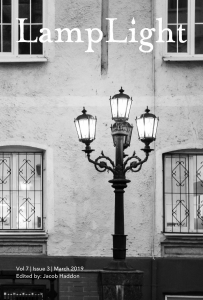 LampLight, <lamplightmagazine.com>, a dark fiction periodical edited by Jacob Haddon, published 15 stories, one a reprint, and three articles in three print and electronic issues, plus “one episode of the LampLight Radio Play – a radio play based on stories from the magazine.” Haddon said, “Science fiction and horror go so well together, we’d like to see more. 2020 is our eight-year anniversary!” Cover price was $7.99/print and $2.99/electronic. Pay was $.03/word to $150 max, $.01/word for reprints. [Semiprozine]
LampLight, <lamplightmagazine.com>, a dark fiction periodical edited by Jacob Haddon, published 15 stories, one a reprint, and three articles in three print and electronic issues, plus “one episode of the LampLight Radio Play – a radio play based on stories from the magazine.” Haddon said, “Science fiction and horror go so well together, we’d like to see more. 2020 is our eight-year anniversary!” Cover price was $7.99/print and $2.99/electronic. Pay was $.03/word to $150 max, $.01/word for reprints. [Semiprozine]
Fiyah, <www.fiyahlitmag.com>, the “Magazine of Black Speculative Fiction,” published 17 original stories plus eight poems in four scheduled electronic issues, two centered on the themes of “Hair” and “Chains”. Executive editor Troy L. Wiggins said, “We were also nominated for a Hugo Award in the Best Semiprozine category and fundraised for a first-time meeting of our team for the occasion. We introduced reviews of black speculative fiction novels…. We finished the year with our annual VoicesOnFIYAH event, and revealed our first animated cover!” Pay was a flat $150 for short stories; $300 for novelettes, $50 for poetry, and $250 for cover art. There were 204 subscriptions ($15/year) and 104 issue purchases ($3.99) as of September. [Semiprozine]
 Space and Time, <www.spaceandtimemagazine.com>, produced three regular issues and one double, 48 pages, b&w with glossy color covers, with 19 original stories, 43 poems, two serial installments, and some non-fiction, available in print, digital, and audio book. Angela Yuriko-Smith (publisher and editor-in-chief) and Ryan Aussie Smith (publisher and narrator) took over operations from longtime editor-in-chief Hildy Silverman in 2019, saving the magazine from closure. Yuriko-Smith said, “Our goal with S&T is to preserve the magazine’s history and promote the speculative genre and literacy…. We’ve put together a historic exhibit of artifacts from S&T history that travels on display through the local Mid-Continent Public Library system (32 library system). We have… a regular open mic event for poets and prosers….” Print run was 950, 100 print subscribers and 150-200 digital. The website gets 1,000-3,000 hits per month, and unique visitors “sharply climbed to somewhere around 500-1,000.” Cover price was $7.00, up from $6.00; $9.99 for ebook subscription. Pay rate was $.01/word, $5.00 per poem. [Semiprozine]
Space and Time, <www.spaceandtimemagazine.com>, produced three regular issues and one double, 48 pages, b&w with glossy color covers, with 19 original stories, 43 poems, two serial installments, and some non-fiction, available in print, digital, and audio book. Angela Yuriko-Smith (publisher and editor-in-chief) and Ryan Aussie Smith (publisher and narrator) took over operations from longtime editor-in-chief Hildy Silverman in 2019, saving the magazine from closure. Yuriko-Smith said, “Our goal with S&T is to preserve the magazine’s history and promote the speculative genre and literacy…. We’ve put together a historic exhibit of artifacts from S&T history that travels on display through the local Mid-Continent Public Library system (32 library system). We have… a regular open mic event for poets and prosers….” Print run was 950, 100 print subscribers and 150-200 digital. The website gets 1,000-3,000 hits per month, and unique visitors “sharply climbed to somewhere around 500-1,000.” Cover price was $7.00, up from $6.00; $9.99 for ebook subscription. Pay rate was $.01/word, $5.00 per poem. [Semiprozine]
Shoreline of Infinity, <www.shorelineofinfinity.com>, based out of Scotland, published 40 new stories, 24 poems, and some non-fiction in three regular issues, 130-134 pages, plus one special 120-page issue, a retrospective reprinting of stories from the first ten issues, all perfect bound, digest-sized with b&w interiors and glossy color covers. Editor Noel Chidwick said, “Shoreline of Infinity was nominated again for British Fantasy Society award for best magazine and periodical, but our proudest moment was for best non-fiction of the year for Ruth EJ Booth for her column ‘Noise and Sparks’. We also produced our first podcast series, Shoreline of Infinity‘s Soundwave… hosted by RJ Bayley.” Print run was flat at 175, with print sales to bookshops through distributors growing via POD. Cover price went up to £3.45 digital/£7.50 print, subscribers were 90 up from 60, with 3,600 unique website visitors monthly. Pay rate was £10/1,000 words. [Semiprozine]
 We saw three print issues of Into the Ruins, <intotheruins.com>, perfect bound with b&w interiors and glossy color covers of painted landscapes, from 105-112 pages, with 16 original short stories and one serialized novella in two parts, on the topic of deindustrial SF and realistic environmental and social speculation. Editor was Joel Caris. Average sales were around 165 per issue. Cover price was $12 for print, $7.50 ebook. Pay rate was $.005/word. [Semiprozine]
We saw three print issues of Into the Ruins, <intotheruins.com>, perfect bound with b&w interiors and glossy color covers of painted landscapes, from 105-112 pages, with 16 original short stories and one serialized novella in two parts, on the topic of deindustrial SF and realistic environmental and social speculation. Editor was Joel Caris. Average sales were around 165 per issue. Cover price was $12 for print, $7.50 ebook. Pay rate was $.005/word. [Semiprozine]
GigaNotoSaurus, <giganotosaurus.org>, published six fantasy or SF pieces online: “longer than a short story, and shorter than a novel.” LaShawn M. Wanak was announced as editor in August. Pay rate was $100/story. [Semiprozine]
Flash Fiction Online, <flashfictiononline.com>, a monthly edited by Suzanne Vincent posted 12 scheduled issues for a total of 48 flash fiction pieces – 33 original and 15 reprints. Publisher Anna Yeatts said, “Horror and dark fantasy plus science fiction stories with unique yet approachable voices always get a great response from our readership.” Pay rate was $0.02/word for reprints and, as of August, $0.08/word for original stories between 500-1,000 words. “Roughly 30,000 hits per month” and 200 subscribers. [Semiprozine]
 We saw two issues of Alien Dimensions, <aliendimensions.com>, perfect bound, 15 x 23 cm, 76-96 pages, with glossy color covers of space scenes and b&w interiors, including 16 original short stories. The magazine was available in ebook and POD. Editor Neil A. Hogan said, “I would like to see more hard SF, stories from a non-anthropomorphic alien’s point of view, and original space opera.” Print cover price was $7.95, ebook $2.99, or free with subscription to Kindle Unlimited. Pay rate was $10 per story. [Semiprozine]
We saw two issues of Alien Dimensions, <aliendimensions.com>, perfect bound, 15 x 23 cm, 76-96 pages, with glossy color covers of space scenes and b&w interiors, including 16 original short stories. The magazine was available in ebook and POD. Editor Neil A. Hogan said, “I would like to see more hard SF, stories from a non-anthropomorphic alien’s point of view, and original space opera.” Print cover price was $7.95, ebook $2.99, or free with subscription to Kindle Unlimited. Pay rate was $10 per story. [Semiprozine]
James Gunn’s Ad Astra, <www.adastrasf.com>, “the best parts of creative magazines and scholarly journals,” published one issue with six stories. Editor-in-chief Jean Asselin said, “We plan to increase our publication schedule to at least two issues per year…. Our distinguishing quality remains a willingness to work with an author whose story is close to publishable but not quite done.” Pay was $50/story. [Semiprozine]
Science Fiction Trails, <www.steampunktrails.blogspot.com>, published one print issue, full-sized and perfect bound, 84 pages with six original weird Western science fiction stories and a glossy color cover of an alien hitchhiking. According to editor and publisher David B. Riley, issue #14 will be the final issue of the magazine. Cover price was $6.95. [Semiprozine]
Red Sun, <noselloutproductions.com>, published 18 original stories in two online issues. In November 2019 Ben Richards stepped down as editor-in-chief and “passed the torch” to Jason Duke. Duke said, “We would like to see more military science fiction,” and reported 2,800 hits per month. Pay was $0.03/word. [Semiprozine]
Kasma, <www.kasmamagazine.com>, published 12 stories total online: nine original and three reprint, one story per month. Editor Alex Korovessis said, “Our most popular story was ‘The Soulmate Requirement’.” Pay was $25/story or art piece. Average unique visitors per month was 270. [Semiprozine]
Three Crows, <threecrowsmagazine.com>, edited by Alex Khlopenko, published 14 stories in four online issues. “2019 was a period of growth and establishing our tastes for more weird fiction and longer works (we started at 4k words limit and now changed to 15k)…. The best response came for Eliza Chan’s ‘Knowing Your Type’ – magical realism/yellow fever horror story, Anna Smith Spark’s feminist slice-of-life fantasy ‘Stones’ about toxic masculinity and the free-roaming selkies, and the melancholic short from Luke Frostick ‘Redundancy of Yellow Flower Tea’ about the tax collector wanting to save the world from ecological disaster.” Cover price was $2.99/ebook, with on-demand printing in the near future. Pay was $25/piece, with 1,700–2,000 unique visitors a month and 50 downloads/issue. [Semiprozine]
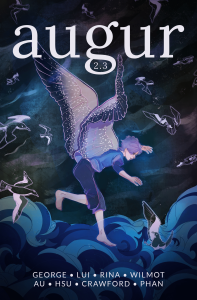 Augur, <www.augurmag.com>, an online literary spec-fic magazine, published four reprints, 11 original stories, three comics, and 13 poems, in three issues. Publisher Kerrie Seljak-Byrne said, “We plan to almost double our pay rate in 2020…. We will also be reducing the number of issues from three to two…. We love rich and atmospheric fantasy; dreamy literary realism; quiet and gorgeous fabulism; considered and eerie light scifi and apocalyptic fiction; and any mix of the above, or slipstream.” 250 subscribers, 1,800-3,800 views each issue. Pay was C$0.06/word, in 2020 C$0.11/word. [Semiprozine]
Augur, <www.augurmag.com>, an online literary spec-fic magazine, published four reprints, 11 original stories, three comics, and 13 poems, in three issues. Publisher Kerrie Seljak-Byrne said, “We plan to almost double our pay rate in 2020…. We will also be reducing the number of issues from three to two…. We love rich and atmospheric fantasy; dreamy literary realism; quiet and gorgeous fabulism; considered and eerie light scifi and apocalyptic fiction; and any mix of the above, or slipstream.” 250 subscribers, 1,800-3,800 views each issue. Pay was C$0.06/word, in 2020 C$0.11/word. [Semiprozine]
Capricious, <www.capricioussf.org>, “a magazine of literary speculative fiction and criticism,” edited by A.C. Buchanan, published two online issues with eight original stories before taking a planned hiatus. Pay was $50/story but “will be changing when we return from hiatus” in 2020, with a new format. [Semiprozine]
Helios Quarterly, <heliosquarterly.com>, published four online issues and 17 stories, including one Spanish translation. Publisher and editor Zelda Knight plans to “shift towards print next year, and create an active subscription base to sustain Helios & Selene. Genre mash-ups like ‘Hive’ (historical zombie horror) got a great response this year.” Unique monthly visitors were 746. Pay was $0.02-.03/word. [Semiprozine]
Flash fiction market Factor Four, <factorfourmag.com>, edited by Richard Flores IV, published three issues with 40 stories before permanently closing in December. Pay was $.08/word. [Semiprozine]
 Selene Quarterly, <selenequarterly.com>, “speculative romance, mystery, and alternate history,” published three issues with three poems and 10 stories online, including two translations: Spanish and Polish. “Queer protagonists like the bisexual witch in ‘Rosemary and Jasmine’, as well as protagonists of color like those that populate Afrofuturist short story ‘Ife-Iyoku’ got a wonderful response this year.” Unique monthly visitors were 425. Pay was $0.25/line for poetry, $0.02-.03/word for fiction. [Semiprozine]
Selene Quarterly, <selenequarterly.com>, “speculative romance, mystery, and alternate history,” published three issues with three poems and 10 stories online, including two translations: Spanish and Polish. “Queer protagonists like the bisexual witch in ‘Rosemary and Jasmine’, as well as protagonists of color like those that populate Afrofuturist short story ‘Ife-Iyoku’ got a wonderful response this year.” Unique monthly visitors were 425. Pay was $0.25/line for poetry, $0.02-.03/word for fiction. [Semiprozine]
New Myths, <newmyths.com>, published 36 stories online plus poems, and art in four issues. Editor Scott T. Barnes said, “Humor is always well received… and we don’t get enough of it. We published our first anthology in 2019…. Our second anthology Twilight Worlds is coming out in 2020 with a third in the works.” There were around 200 visitors on the site/month, for around 2,000 hits. Pay was 1.5 cents/word, minimum of $30. [Semiprozine]
Bards and Sages Quarterly, <www.bardsandsages.com>, published 46 short stories in four online issues. In February they launched new magazine The Society of Misfit Stories. Three issues were published with 35 stories. Pay was $25 for original fiction, $10 for reprints. [Semiprozine]
 Australian Aurealis, <aurealis.com.au>, published 30 stories in ten online issues. Editor Dirk Strasser said, “Fresh takes on old tropes got the best response for the year. We would like to see more submissions from outside the US, UK, and Australia. We are publishing an all-New Zealand issue for the WorldCon.” Pay rate was between A$20 and A$60 per 1,000 words. Parent company Chimaera Publications also ran the Aurealis Awards. [Semiprozine]
Australian Aurealis, <aurealis.com.au>, published 30 stories in ten online issues. Editor Dirk Strasser said, “Fresh takes on old tropes got the best response for the year. We would like to see more submissions from outside the US, UK, and Australia. We are publishing an all-New Zealand issue for the WorldCon.” Pay rate was between A$20 and A$60 per 1,000 words. Parent company Chimaera Publications also ran the Aurealis Awards. [Semiprozine]
Australian Andromeda Spaceways, <andromedaspaceways.com>, published four online issues with 42 stories and three poems, plus 2018’s Best Stories with 13 reprints. “Lots of submissions made us tighten our submission windows a little bit. Our Writers Unearthed section, where we interview up-and-coming local authors, always gets a good response.” Pay for original short fiction was A$.01/word, A$10.00 (min) and A$100.00 (max). [Semiprozine]
Kaleidotrope, <www.kaleidotrope.net>, a quarterly, published 26 stories in four quarterly online issues. Editor Fred Coppersmith said, “2019 was a very good year for SFF fiction and poetry…. At the same time, it’s not lost on me that many prominent venues have recently closed, and SFWA’s (absolutely justified) rate increase could potentially make it more difficult for those venues that remain…. Great to see Kaleidotrope stories from 2018 (like Octavia Cade’s ‘The Temporary Suicides of Goldfish’) make the Locus Poll and Rich Horton’s best-of-the-year anthology….” Kaleidotrope will be closed to submissions for 2020, planning to re-open to submissions in 2021. This site had 8,000-10,000 visitors a month. Pay was $.01/word, $5 for poetry, $60 for artwork. [Semiprozine]
Heroic Fantasy Quarterly, <www.heroicfantasyquarterly.com>, published 14 original short stories, one reprint short story, and seven poems in their four scheduled online issues, plus a hardcopy “Best Of” anthology. Editor Adrian Simmons said, “We had our 10-year anniversary issue and we had stories from Martha Wells, Adrian Cole, and Darrell Schweitzer…. We are always looking for more ‘sorcery’ oriented stories, and continue our ongoing quest for ‘clever thief’ stories that aren’t ‘clever thief’ stories.” There were about 700 uniques per month. Pay was $100 for fiction, $25 for poems, with some variation based on length. [Semiprozine]
 Anathema, <www.anathemamag.com>, focusing on “weird, slipstream, surrealism, fabulism, and more by queer people of colour on every range of the LGBTQIA spectrum,” published 13 stories, six poems, and two articles in three scheduled online issues. Editor Michael Matheson said, “We added poetry to our regular lineup starting with Issue 7, ran a successful crowdfunding campaign to fund 2020’s costs, and managed to snag two absolutely gorgeous original covers…. We’re big fans of a good ghost story. But we always want to see more lighter, quieter work as well – slice of life, love stories and romances, and just gentle, generous humour.” Pay was C$100 for fiction/, C$50 for poetry, and C$200 for cover art. There were around 1,000 uniques/month, 137 subscriptions. [Semiprozine]
Anathema, <www.anathemamag.com>, focusing on “weird, slipstream, surrealism, fabulism, and more by queer people of colour on every range of the LGBTQIA spectrum,” published 13 stories, six poems, and two articles in three scheduled online issues. Editor Michael Matheson said, “We added poetry to our regular lineup starting with Issue 7, ran a successful crowdfunding campaign to fund 2020’s costs, and managed to snag two absolutely gorgeous original covers…. We’re big fans of a good ghost story. But we always want to see more lighter, quieter work as well – slice of life, love stories and romances, and just gentle, generous humour.” Pay was C$100 for fiction/, C$50 for poetry, and C$200 for cover art. There were around 1,000 uniques/month, 137 subscriptions. [Semiprozine]
Grimdark, <grimdarkmagazine.com>, published 11 stories in three issues focusing on “the grittier nature of people in futuristic or fantasy settings.” Founder Adrian Collins was editor-in-chief. Collins said, “Our Patreon subscribers want to see more stories from authors they are less likely to have heard of – hence our open window to try and gather the best stories from the lesser-known author community.” Collins reported 10,000 hits/month. Pay was A$.07/word. [Semiprozine]
The Future Fire, <futurefire.net>, a quarterly magazine of progressive, feminist, queer, eco, multicultural, and cyberpunk fiction published four issues with 21 short stories and 16 poems, one flash fiction piece, one novelette, seven poems, and an anthology. Editor Djibril al-Ayad said, “The highlight of 2019 was our fiftieth issue…. In 2020 we’ll publish our first explicit issue of hoax fiction (invented content that we’ll pass off as non-fiction or reviews). It’s something I’ve always wanted to do, so I’m looking forward to see how it works.” There was an average of 700 uniques/month. Pay was $20 for short fiction. [Semiprozine]
 We saw four issues of Pulp Literature, <pulpliterature.com> with 37 stories (one reprint) plus two serial installments, 12 poems, and two comics/graphic shorts, print and electronic. Print was digest size, perfect bound with glossy color cover and b&w interior. According to managing editor Jennifer Landels, “We are moving… to ongoing submissions. Coming up in 2020 we have stories from A.M. Dellamonica, Matthew Hughes, Rebecca Ruth Gould, Robert Silverberg, Sylvia Leong, and more.” Subscriber base was around 370 (270 digital/100 print), plus single-copy sales of around 90/issue. Pay rates were $0.035 to $0.07/word. Price was C$14.99 print, C$4.99 electronic. [Semiprozine]
We saw four issues of Pulp Literature, <pulpliterature.com> with 37 stories (one reprint) plus two serial installments, 12 poems, and two comics/graphic shorts, print and electronic. Print was digest size, perfect bound with glossy color cover and b&w interior. According to managing editor Jennifer Landels, “We are moving… to ongoing submissions. Coming up in 2020 we have stories from A.M. Dellamonica, Matthew Hughes, Rebecca Ruth Gould, Robert Silverberg, Sylvia Leong, and more.” Subscriber base was around 370 (270 digital/100 print), plus single-copy sales of around 90/issue. Pay rates were $0.035 to $0.07/word. Price was C$14.99 print, C$4.99 electronic. [Semiprozine]
Omenana, <omenana.com>, speculative fiction “from across Africa and the African Diaspora,” published 14 stories and an essay. Co-founder and managing editor Chiagozie Nwonwu said, “2019 was tough for us. Our co-founder stepped down as editor and we couldn’t get funding to adequately pay writers and artists. We also had to hire an outside editor but couldn’t pay to keep them full-time. We are hoping to keep going in 2020 and hope for the best. We have a funding link on our page but since we are based in Nigeria, which is restricted by PayPal, we find we are not getting support at all.” Highlights included Ada Nnadi’s “Tiny Bravery” and Haku Jackson’s “The Silent God”. “Both writers are exciting and we expect to see more of them in the future.” There was an average of 500 uniques/month and 2,316 subscribers. Pay was N5,000 per story and N5,000 per art work. [Semiprozine]
Non-profit Electric Spec, <www.electricspec.com>, published four scheduled issues with 25 original stories. Editors were Nikki Baird, Lesley L. Smith & Grayson Towler. Pay was $20/story, with average unique visits of 238 per month and average hits of 1,262. [Semiprozine]
 Lackington’s, <lackingtons.com>, published two issues and 17 stories. Ranylt Richildis, editor-in-chief, said, “The stories that received the most enthusiasm among reviewers were the kind that we ‘aren’t supposed to write, according to workshop rules: little to no plot, descriptive, wordy, and full of telling. Xue Xihe’s ‘Enchiridion of the Soltite,’ a found MS travel brochure, is one example. It’s just luminous in its departure from template….” Pay was C$.01/word, $25 minimum, and C$25-C$40 for artwork. [Semiprozine]
Lackington’s, <lackingtons.com>, published two issues and 17 stories. Ranylt Richildis, editor-in-chief, said, “The stories that received the most enthusiasm among reviewers were the kind that we ‘aren’t supposed to write, according to workshop rules: little to no plot, descriptive, wordy, and full of telling. Xue Xihe’s ‘Enchiridion of the Soltite,’ a found MS travel brochure, is one example. It’s just luminous in its departure from template….” Pay was C$.01/word, $25 minimum, and C$25-C$40 for artwork. [Semiprozine]
Mithila, <mithilareview.com>, published two of four planned issues with 13 original stories. Editor Salik Shah said, “We had a difficult year due to lack of funding. That said, we do plan to bring out all four issues and one anthology in 2020.” $10.00 for poetry and a minimum of $10.00 for fiction. Patreon/subscriber numbers were around 50, with “upwards of 5,000” uniques per month. [Semiprozine]
Three-Lobed Burning Eye, <www.3lobedmag.com>, edited by Andrew S. Fuller, published six stories in one of two planned issues, saying, “We read over 1,800 submissions this year to find 6 stories…. We hope to publish more magical realism and speculative fiction, especially from more writ ers of color, translations, and indigenous writers.” They had 1,000 visitors/month, 20 ebook purchases/month, and 50 subscribers. $100/short story, $30/flash fiction. [Semiprozine]
There was one issue of Neo-opsis, <www.neo-opsis.ca>, 80 pages, digest-sized, with seven stories and assorted non-fiction, with a semi-gloss color cover and smooth book print inside. Editor was Karl Johanson. Print run was 800, with 121 subscribers, a bookstore distribution of 435 with 40% sell-through, and 48 other assorted issue sales. Cover price was C$9.00. Fiction pay rate was C$.025/word, capping at $125. [Semiprozine]
In poetry, we received three issues of Dreams & Nightmares, <www.dreamsandnightmaresmagazine.com>, priced at $5.00 with 59 original poems. Print run was 150, with a print subscriber base of about 90 and around 20 PDF-format subscribers. Editor David Kopaska-Merkel said, “Poems with well-developed characters with personal investment in dealing with the challenges that they face always get a positive response.” Pay rate was $12, planned to raise next year. [Semiprozine]
Star*Line, <www.sfpoetry.com/starline.html>, the journal of the Science Fiction and Fantasy Poetry Association, produced four issues priced at $5.00, with 326 poems total, in print and PDF memberships and subscriptions. Pay rate was $.03/word, minimum of $3. Editor was Vince Gotera. The SFPA also published 71 poems in Eye to the Telescope, a quarterly online speculative poetry journal with a different theme and editor each issue: <www.eyetothetelescope.com>. [Semiprozine]
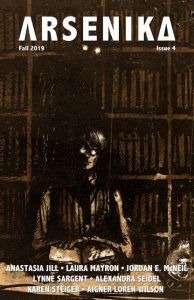 Arsenika, <arsenika.ink>, edited by S. Qiouyi Lu, came out of hiatus to publish seven poems in one issue. Pay was $60 for flash fiction, $30 for poetry. “For 2020, I plan to have only two submission windows (April and October).” 300–500 unique visitors/month, peaking with 1,500 visitors around submissions. [not eligible]
Arsenika, <arsenika.ink>, edited by S. Qiouyi Lu, came out of hiatus to publish seven poems in one issue. Pay was $60 for flash fiction, $30 for poetry. “For 2020, I plan to have only two submission windows (April and October).” 300–500 unique visitors/month, peaking with 1,500 visitors around submissions. [not eligible]
We saw two issues of perennial favorite Enchanted Living (formerly Faerie Magazine), <enchantedlivingmagazine.com>, and one issue each of Heavy Feather Review Presents the Future, <heavyfeatherreview.org>; Visions, <readvisions.com>; Planet Scumm, <www.planetscumm.space>; and Curiosities, a retropunk magazine, <gallerycurious.com>. Phantom Drift was missing in action despite outreach attempts, but according to <phantomdrift.org> had one issue of the usual high quality out in 2019.
PODCASTS
AUDIO FICTION
Marguerite Kenner, COO of Escape Artists, Inc., said EA published a combined total 211 episodes with 230 stories in Escape Pod (SF), PodCastle (fantasy), PseudoPod (horror), and Cast of Wonders (YA). Estimated audience sizes were Escape Pod (37,000), PseudoPod (39,000), PodCastle (16,000), and Cast of Wonders (9,000). All four markets increased pay in September to $0.08/word for original fiction, $100/story for reprints, and $20/flash fiction reprint. “EA also pays all narrators, editors, producers, and administrative staff, and are continuing to fundraise towards paying associate editors (AKA ‘slush readers’). Escape Pod: ‘Spectrum of Acceptance’ by Nyla Bright got some good social media discussions going. PseudoPod: Audiences were hugely impressed with ‘The Coven of Dead Girls’ by L’Erin Ogle and its phenomenal narration by veteran voice talent Nika Harper. PodCastle: Some favorite episodes included ‘I Am Not I’ by G. V. Anderson, ‘Strange Waters’ by Sam Mills, and ‘Elegy for a Slaughtered Swine’ by Rafaela Ferraz. Cast of Wonders: ‘Remember to Breathe’ by Matt Dovey and ‘Blame it on the Bees’ by Rachel Menard were fan-favorite stories spotlighting Pride, along with ‘Why I Spared the One Brave Soul Between Me and My Undead Army’ by Setsu Uzumé from our 2019 Artemis Rising special.”
There were 52 episodes of Escape Pod, <www.escapepod.org>, “The Science Fiction Podcast Magazine.” Kenner said, “We would love to see more humorous and/or hopeful stories; we’re seeing a dystopic trend in submissions but aren’t necessarily looking for such stories.” Editors were S.B. Divya & Mur Lafferty; Tina Connolly & Alasdair Stuart hosted. Average monthly unique visitors: 10,800. [Semiprozine]
PodCastle, <www.podcastle.org>, produced 53 episodes. They were British Fantasy Society finalists for Best Audio. Jen R. Albert & Cherae Clark were co-editors and Setsu Uzumé was host/assistant editor. Average monthly unique visitors: 3,500. [Semiprozine]
PseudoPod, <www.pseudopod.org>, “the sound of horror,” produced 53 episodes. “We were honored to be a finalist for the 2019 British Fantasy Awards in the Best Audio category, alongside PodCastle.” Shawn Garrett & Alex Hofelich were co-editors, and Alasdair Stuart was host. Average monthly unique visitors: 5,100. [Semiprozine]
Kenner stepped down as co-editor of Cast of Wonders <www.castofwonders.org> in December, leaving Katherine Inskip as editor. They published 53 episodes. Kenner said they “ran a Summer Spotlight series to celebrate Lodestar-nominated YA authors and other finalists, including Best Semiprozine Shimmer and Best Novella ‘The Last Banquet of Temporal Confections’ by Tina Connolly. Our annual Banned Books Week special was guest edited by the Hugo award winning Julia Rios.” Average monthly unique visitors was 2,000. [Semiprozine]
Drabblecast, <www.drabblecast.org>, “off-beat, funny, eclecticism in science fiction, fantasy, and horror,” hosted, produced, and narrated by Norm Sherman, produced 50 stories, with 25 originals and 25 reprints, each with original artwork. Pay was $.06/word for original fiction (moving to $.08/word in 2020) and $.03/word for reprint fiction (moving to $.04 in 2020) $25 per piece of episode art. Sherman said, “Our commissioned original stories got the best responses and highest downloads this year. Of those, ‘Necessary Cuts’ by Bryan Miller and ‘The Best Scarlett Ceremony Ever’ by Shaenon K Garrity were the most popular. Possibly also of note, both of these stories reflect some influence of HP Lovecraft or elements of ‘cosmic horror.’ Also popular in 2019 were our commissioned stories for our 9th annual Women & Aliens month in March…. We would like to see more humor…. That’s tough to pull off, as anyone would agree, but we love to snatch those ones up quick when they are pulled off just right!” Average monthly unique downloads were 54,300, average unique site visitors were 3,000, and they had 4,100 newsletter subscribers. [Semiprozine]
StarShipSofa, <www.starshipsofa.com>, produced and hosted by Tony C. Smith published 47 episodes with 48 stories and 2 irregular “Echoes” (re-cast episodes). Fellow District of Wonders podcast FarFetchedFables, <www.farfetchedfables.com>, did not publish in 2019. Pay was $50/story. [Semiprozine]
Tales to Terrify, <talestoterrify.com>, formerly part of the District of Wonders group, is now owned and hosted by Drew Sebesteny and edited by Seth Williams. They published 49 episodes, most with one or two stories. Pay was $50/story. [Semiprozine]
Glittership, <www.glittership.com>, edited by Keffy R.M. Kehrli, published 14 podcast episodes with six original stories, eight reprints, and eight original poems, along with text for each episode; plus two quarterly digital issues of content from the episodes. Pay was $.03/word for originals. [Semiprozine]
FANCASTS
The Coode Street Podcast, <jonathanstrahan.podbean.com>, with hosts Jonathan Strahan & Gary K. Wolfe, produced 23 episodes. Professional SF, fantasy, and horror writers were featured in roundtable-style discussions and interviews, including Liza Trombi, Neil Clarke, Charlie Jane Anders, Sarah Pinsker, Annalee Newitz, Margo Lanagan, Ellen Klages, Eileen Gunn, and Jack Zipes. [Fancast]
Michelle Graham & Giles Hash co-hosted Beyond the Trope, <beyondthetrope.weebly.com>, posting 50 episodes. “Moving into 2020, we’re going to try to pursue more author interviews to discuss genre and craft because we have found that our listeners respond well to those discussions, and we learn more from the experts than we do by chatting amongst ourselves.” Emily Singer left the show in 2019 to pursue other projects. Average downloads per month were 2,500. [Fancast]
Writing Excuses, <www.writingexcuses.com>, produced their 14th season with 52 educational episodes by writers for writers on “Worldbuilding.” Hosted by “core cast” Brandon Sanderson, Mary Robinette Kowal, Howard Tayler, and Dan Wells, they were joined by K. Tempest Bradford, Margaret Dunlap, Natasha Ence, Mahtab Narisiman, and DongWon Song in 2019. “Most weekly episodes get 20,000 listens during the first week… closer to 35,000 listens by the end of the year.” [Related Work]
Galactic Suburbia, <galactisuburbia.podbean.com>, produced nine podcast episodes of SF news and commentary with Alisa Krasnostein, Tansy Rayner Roberts, and Alex Pierce. Krasnostein said, “This year we added access to a Galactic Suburbia Slack for our Patreon supporters. It’s grown into a delightful hubbub of activity, building friendships and rapport between our listeners and ourselves.” Episodes each had 500 to 750 downloads. [Fancast]
Our Opinions Are Correct, <www.ouropinionsarecorrect.com>, hosted by Charlie Jane Anders and Annalee Newitz, produced 26 episodes, the most popular having to do with writing or the intersection of politics and economics. Guests included K. Tempest Bradford, Inkoo Kang, Mallory O’Meara, Nina Shen Rastogi, and K.M. Szpara. Anders said, “Obviously winning the Hugo was a huge confidence boost and helped us to feel like people were paying attention…. For 2020, we’d like to do more author interviews.” [Fancast]
Jennifer Mace, Freya Marske, and Alexandra Rowland produced 26 episodes of Be the Serpent <betheserpent.podbean.com>. “Our 50th episode went live in December… we’re now on the downhill slope towards episode 100.” Downloads averaged 6,500 per month. [Fancast]
Geek’s Guide to the Galaxy, <geeksguideshow.com>, hosted by David Barr Kirtley and produced by John Joseph Adams, published 52 weekly episodes. Popular episodes included panel discussions of “Awesomely Bad ’80s Fantasy Movies” and “Awesomely Bad ’70s and ’80s Science Fiction Movies”. They had about 35,000 unique visitors and 100,000 downloads per month. [Related Work]
Patrick Hester & John Anealio edited Functional Nerds, <www.functionalnerds.com>. They posted 42 episodes, including interviews with Gail Carriger, Delilah Dawson, and Kevin Hearne, though their “Just Us” episodes continue to be the most popular. Hester said, “2019 marked a major milestone for the Functional Nerds – episode 400!” They reported an average of 1,325 downloads per episode. [Fancast]
Fangirl Happy Hour, <www.fangirlhappyhour.com>, “the intersections of fandom, literature, and culture,” produced 11 episodes. Ana & Renay said, “We’re excited about all the new voices from short fiction emerging in the novel market… and are extremely happy to see the undercurrent of socialism in a lot of 2019 releases. Seize the means of production!” They reported 650 monthly website visitors, 300 subscribers. [Fancast]
CRITICAL MAGAZINES
We saw three issues of The Cascadia Subduction Zone: A Literary Quarterly, <www.thecsz.com>, published by Aqueduct, with essays of social and literary criticism, short fiction, poems, reviews, and art. Cover price was $5.00. Managing editor was Arrate Hidalgo. Other editors were Nisi Shawl, L. Timmel Duchamp, and Kath Wilham. [Related Work]
There were two issues of scholarly journal Extrapolation, published by Liverpool University Press, totaling 227 pages, with essays on a variety of critical topics. Andrew Butler was managing editor. Issues were available in print and PDF from <online.liverpooluniversitypress.co.uk/loi/extr>. [Related Work]
We saw three issues of academic journal Foundation, <www.sf-foundation.org/journal>, including special issues on Philip K. Dick and “Shakespeare and SF”. Editor Paul March-Russell picked out decolonization of the genre as a trend of 2019, citing Jeanette Ng’s Campbell Award acceptance speech. “Tade Thompson’s success at the Clarke Award, coming on the back of N.K. Jemisin’s third Hugo in 2018, was just as significant. The SFF was similarly delighted when Nalo Hopkinson agreed to become one of our patrons, following the death in 2018 of Ursula Le Guin.” March-Russell will step down as editor in 2020. Print runs are 280 copies, with a subscriber base of 230-250. [Related Work]
Three issues of The New York Review of Science Fiction were available in ebook. Publisher was Kevin J. Maroney. Subscribers remained at 150-200, with half of each issue’s content available free at <www.nyrsf.com/toc>. Six issues are planned for 2020. [Semiprozine]
Scholarly journal Science Fiction Studies, <www.depauw.edu/sfs>, published three issues, edited by Arthur Evans. The magazine was available in print and digital formats with electronic access through JSTOR. They had approximately 800 individual and institutional subscribers, 65% located within the US and 35% outside. “Approximately 475 are electronic-only while 325 are electronic + print or print-only. This trend toward electronic subscriptions seems to be increasing with each passing year, especially among… institutions (university libraries, public libraries, etc.)” Cover price was $30.00. [Related Work]
There were three issues of SF Commentary, celebrating the magazine’s 50th anniversary, with reviews, essays, and articles. Thanks to an anonymous donation, copies were printed for #99-100, but editor and publisher Bruce Gillespie said “very few print copies will appear of future editions of the magazine” due to financial constraints. Free PDFs available through <www.efanzines.com/SFC>. [Related Work]
There were two issues of Vector, <vector-bsfa.com>, the critical journal of the British Science Fiction Association, edited by Polina Levontin & Jo Lindsay Walton, with articles and reviews on SF in books, games, television, music, and film. Issue 289 was themed “African and Afrodiasporic SF”, guest-edited by Michelle Louise Clarke. Issue 290 included reports from WorldCon 2019 and IceCon 2018. Vector is planning a “Speculative Art” issue for 2020.
Two issues of Wormwood, edited by Mark Valentine, were available from Tartarus Press, with critical works exploring the fantastic, supernatural, and decadent in literature <www.tartaruspress.com/wormwood.html>. Print run was 300, sold direct. Cover price was £9.99. [Semiprozine]
QUALITY
Our gauge for quality is based on our short fiction Recommended Reading list; see chart. We recommended 127 pieces of short fiction from 2019, up from 125. Recommended stories appeared in 22 magazines or online venues, down from last year’s 24. Anthologies had 23 recommended stories, up from last year’s 19, plus an additional 14 from collections, up from last year’s eight. Major anthologies were The Mythic Dream with seven stories and Echoes with six, followed by Current Futures with four and New Suns with three. Uncanny led the magazines/sites with 11 stories, followed by F&SF and Tor.com with seven, Asimov’s and Lightspeed with six, and Clarkesworld, Fireside, and Beneath Ceaseless Skies each with five. The remaining magazines had three or fewer recommended titles.
CONCLUSION
This year we consistently heard from short fiction publishers looking for humor or lighter fiction; hard to say that audience response is not in part due to the stresses out there in today’s world. Also new, international, and diverse voices are being seen almost across the board, and many publishers would like to see more submissions from those writers. And some requests for more science fiction.
We’re seeing markets hoping to tap new audiences with print, perhaps for the tangibility and notion of permanence that print brings, or perhaps they’re hitting the digital audience peak. Every platform brings its own readership. Print, however, is only affordable from the publishing end when you get to POD or high-priced subscriptions (eg Fireside‘s $120 for four issues, or several mags at $19.95 per issue). While printing itself can be done relatively affordably (~$1 per issue), its storage of inventory, fulfillment, shipping, shrinkage (i.e. B&N somehow doesn’t have the quantity they received anymore), affidavit returns (trust us, we’re destroying the unsold copies), and reshipping charges that quickly undercut profits. And to be honest, it’s always paying staff that is the biggest expense, and many of the magazines survive by only paying contributors and not editors. There’s lots of crowdfunding, but not a lot of magazines hitting the professional “paid one employee 25% of their income” marker.
If you read these magazines, remember most of this content is paid for, even if you get to read it for free. Subscribe, donate, advertise, and support, so that we can continue to enjoy a vibrant short fiction market.
[2/24/20: Edited to include pay-to-play info about submission fees for F(r)iction, Unfit, and Unreal.]
This and more like it in the February 2020 issue of Locus.
 While you are here, please take a moment to support Locus with a one-time or recurring donation. We rely on reader donations to keep the magazine and site going, and would like to keep the site paywall free, but WE NEED YOUR FINANCIAL SUPPORT to continue quality coverage of the science fiction and fantasy field.
While you are here, please take a moment to support Locus with a one-time or recurring donation. We rely on reader donations to keep the magazine and site going, and would like to keep the site paywall free, but WE NEED YOUR FINANCIAL SUPPORT to continue quality coverage of the science fiction and fantasy field.


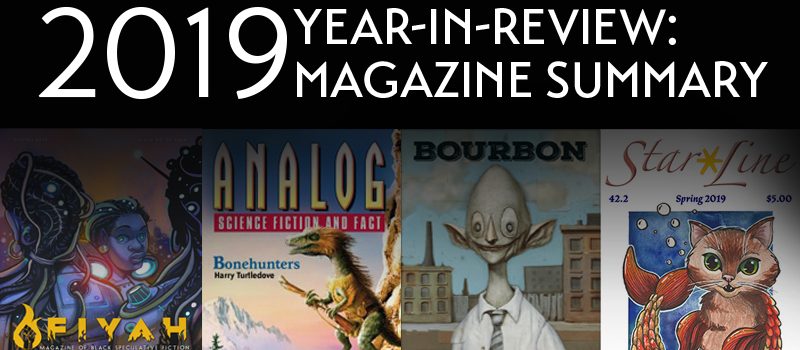




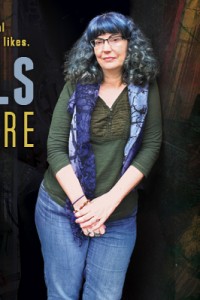

I wonder how popular StoryHack is going to need to be before it can start making these lists.